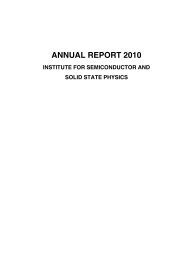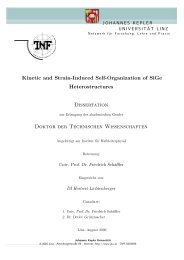Diplomarbeit Diplom-Ingenieur - Institut für Halbleiter
Diplomarbeit Diplom-Ingenieur - Institut für Halbleiter
Diplomarbeit Diplom-Ingenieur - Institut für Halbleiter
Create successful ePaper yourself
Turn your PDF publications into a flip-book with our unique Google optimized e-Paper software.
Abstract<br />
Nano-structuring allows the manipulation of electronic and optical properties of<br />
semiconductors, which is useful for various applications. So-called quantumdots (QD) reveal<br />
optical properties comparable with atoms. They are a promising method for the production of<br />
material systems for opto-electronic devices in frequency ranges, which are not accessible<br />
with the standard materials.<br />
A novel approach of QD formation was realized by decomposition of two immiscible<br />
semiconductors with different lattice structures. The experiments were carried out at<br />
CdTe/PbTe heterostructures. PbTe possesses the structure of rock salt (rs), CdTe has<br />
zincblende (zb) structure. A PbTe layer, embedded in CdTe, disintegrates into highly<br />
symmetrical nano-crystals with atomically sharp interfaces during an annealing step. The QDs<br />
show intense photoluminescence in the mid-infrared, an energy region, where the excitation<br />
energies of molecules are found. No efficient semiconductor lasers exist for this frequency<br />
range. The aim of this work was a concise characterisation of these QDs with transmission<br />
electron microscopy (TEM), for which different techniques were used.<br />
As will be shown, the PbTe nanocrystals have a thermodynamic equilibrium shape of<br />
small rhombi-cubo-octahedrons with {001}, {110} and {111} PbTe/CdTe interfaces. An<br />
insight into the processes during the annealing step is given. The size of the QDs can be<br />
controlled by the epi-layer thickness. The density of the dots depends strongly on their<br />
average size.<br />
The main part of this thesis is the atomic characterisation of the PbTe/CdTe interfaces and<br />
TEM image simulations, which are necessary for the interpretation. The different lattice<br />
structures of the two materials induce strong atomic displacement of single atoms or groups of<br />
atoms at the interfaces. The displacements end up in bonding configurations for the zb or rs<br />
lattice close to their respective bulk configuration. It was shown that two different {001}<br />
interfaces exist at the same QD, depending on the termination of the CdTe crystal half. The<br />
most remarkable effects can be found at the {110} interfaces, where the displacements lead to<br />
a shift of more than 10% of the two crystal halves against each other. The interface problem<br />
was also treated by R. Leitsman et al. with ab-initio calculations. The theoretical<br />
displacements and those obtained by high resolution TEM images show excellent agreement.<br />
v











